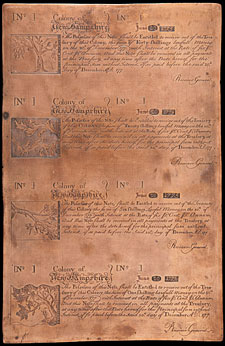Rare New Hampshire Colonial Copper Finds a New Past
 New Hampshire Colonial Copper Plate, dating back to June 20, 1775.
New Hampshire Colonial Copper Plate, dating back to June 20, 1775. Photograph courtesy of Heritage Auctions
A very rare New Hampshire Colonial Copper printing plate dating to June 20, 1775, was one of the principal highlights of a recent Heritage Auctions' Signature® ANA Currency Auction, until it was pulled from the auction due to litigation between the consignor and the State of New Hampshire.
The plate was originally thought to be the engraving work of Paul Revere, due to striking similarities of form, layout and style of earlier plate linked to Revere.
"For many years, the engravings for these particular notes was attributed to silversmith and Colonial Patriot Paul Revere based on circumstantial evidence," says Kathy Lawrence, Currency Cataloger fot Heritage Auctions. "Revere engraved and printed very similar notes for the Massachusetts issues of May 25, 1775 and July 8, 1775 and therefore it was believed that he also engraved the notes for the June 20, 1775 New Hampshire issue. However, recent research by Dr. Frank Mevers, the Head Archivist at the New Hampshire State Archives, revealed that the New Hampshire notes were actually engraved and printed by John Ward Gilman. As part of the authorization by the New Hampshire Provincial Congress on June 9, 1775, it was mandated that the notes be comparable to the copperplate issue of May 25, 1775 by the Colony of Massachusetts Bay thus leading to the inference that Revere engraved the plate. Gilman was a renowned silversmith and engraver as well and his family was quite prominent in New Hampshire."
This rare plate made entirely of copper with a thickness of .08 inches, featured four different engraved denominations of Colonial notes authorized in denominations of 1 shilling, 6 shillings, 20 shillings, and 40 shillings.
"The plate was used in New Hampshire to print four denominations of Colonial notes issued by the colony and dated June 20, 1775. In the Act of June 21, 1794, they were referred to as "Copperplate notes," adds Lawrence. "In general, any surviving plates from Colonial paper money issues are very rare."
The vignettes contained within each engraving were later modified circa 1855 by an unknown hand.
"The plate is well preserved. However, circa 1855, a few modifications were made to the designs as part of an agreement with the State of New Hampshire to allow collector Joshua Cohen to issue reprints of the notes," says Lawrence.
Resources:
Also in this Issue:
- Arline Fisch: Crafting Whimsy While Pioneering Art
- Suzanne Donazetti: Free Falling for Copper
- Rare New Hampshire Colonial Copper Finds a New Past
- Modern Abstract Decor: Melding Modern Art and Science
- Monumental Matisse Sculpture up for Auction at Christie's
